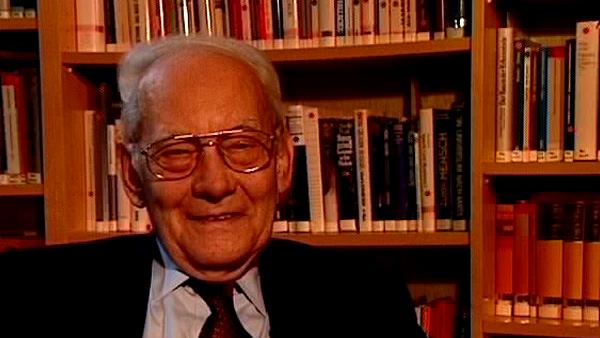NEXT STORY

The 3SR method
RELATED STORIES

NEXT STORY

The 3SR method
RELATED STORIES


|
Views | Duration | |
|---|---|---|---|
| 71. Renormalisation and stochastic theory | 149 | 03:48 | |
| 72. Evolution is a quick process whenever the conditions are good | 107 | 01:29 | |
| 73. David Blow's work on the structure of a pancreatic enzyme | 101 | 03:35 | |
| 74. Subtilisin had exactly the same proton relay | 92 | 01:50 | |
| 75. Lerner and Schultz – making catalysts from antibodies | 113 | 03:49 | |
| 76. The evolution of viruses | 126 | 02:11 | |
| 77. Evolutionary technology | 103 | 04:18 | |
| 78. The PCR method | 112 | 03:57 | |
| 79. The 3SR method | 100 | 04:05 | |
| 80. The serial transfer experiment with more than one sample | 95 | 02:53 |


What you do is you introduce now all the successes in biochemical technologies into this field, and there are two possible... or several possible ones. First of all, we are able nowadays to amplify single molecules. Amplify let's say single RNA or DNA molecules. A Nobel Prize has been given for that discovery. There is the well known PCR method, PCR is an abbreviation for polymerase chain reaction. What is this polymerase chain reaction? Well, you simply mimic nature, and nature polymerises single RNA molecules, and we talked about the stochastic nature of evolutionary theory, from single mutants by an enzyme via a so-called polymerase. Now the trick of the PCR method is that a very special enzyme was chosen, namely an enzyme which can stand high temperatures. It was an enzyme from a thermophile microorganism. This microorganism you find in hot sources on the ground of oceans and so... and you can isolate the enzyme from those organisms here... aquaticus... therefore it's called Taq polymerase, Thermus aquaticus, T-a-q, and this enzyme has its optimum temperature above 70°C.
And now you make the following: you start with your sample which you want to amplify, you add to your system your building blocks for making nucleic acids, you have to make them from the energy-rich triphosphates, and you start with two primers. The primer is a sequence which is complementary to the sequence you want to amplify, and you need two because you need one for the plus strand and one for the minus strand. Now these primers bind at low temperature, so your first stage of the reaction is you're at 40°C. The primers... the two primers bind, one on the plus, one on the minus strand... and then you raise your temperature up to let's say 70°, 75°C, depending on what you are amplifying. Then the region between the two primers will be amplified. You make first two molecules of the one you have there is doubled, then you go up to above 90°C then they would come apart. Now you are back to the first stage, because now to the two molecules, primers will bind. You go to the optimal polymerisation temperature and again to 90°C... in each temperature cycle you double your number of molecules. So after two you have two, then four, then eight, sixteen, we had this before, and after thirty cycles you have 230, which is a billion molecules, and here you have now a macroscopic event.
Nobel Prize winning German biophysical chemist, Manfred Eigen (1927-2019), was best known for his work on fast chemical reactions and his development of ways to accurately measure these reactions down to the nearest billionth of a second. He published over 100 papers with topics ranging from hydrogen bridges of nucleic acids to the storage of information in the central nervous system.
Title: The PCR method
Listeners: Ruthild Winkler-Oswatitch
Ruthild Winkler-Oswatitsch is the eldest daughter of the Austrian physicist Klaus Osatitsch, an internationally renowned expert in gas dynamics, and his wife Hedwig Oswatitsch-Klabinus. She was born in the German university town of Göttingen where her father worked at the Kaiser Wilhelm Institute of Aerodynamics under Ludwig Prandtl. After World War II she was educated in Stockholm, Sweden, where her father was then a research scientist and lecturer at the Royal Institute of Technology.
In 1961 Ruthild Winkler-Oswatitsch enrolled in Chemistry at the Technical University of Vienna where she received her PhD in 1969 with a dissertation on "Fast complex reactions of alkali ions with biological membrane carriers". The experimental work for her thesis was carried out at the Max Planck Institute for Physical Chemistry in Göttingen under Manfred Eigen.
From 1971 to the present Ruthild Winkler-Oswatitsch has been working as a research scientist at the Max Planck Institute in Göttingen in the Department of Chemical Kinetics which is headed by Manfred Eigen. Her interest was first focused on an application of relaxation techniques to the study of fast biological reactions. Thereafter, she engaged in theoretical studies on molecular evolution and developed game models for representing the underlying chemical proceses. Together with Manfred Eigen she wrote the widely noted book, "Laws of the Game" (Alfred A. Knopf Inc. 1981 and Princeton University Press, 1993). Her more recent studies were concerned with comparative sequence analysis of nucleic acids in order to find out the age of the genetic code and the time course of the early evolution of life. For the last decade she has been successfully establishing industrial applications in the field of evolutionary biotechnology.
Tags: RNA, DNA, PCR, polymerase chain reaction, Nobel Prize, Taq polymerase, Thermus aquaticus, nucleic acids, triphosphates, enzyme, stochastic theory
Duration: 3 minutes, 58 seconds
Date story recorded: July 1997
Date story went live: 24 January 2008